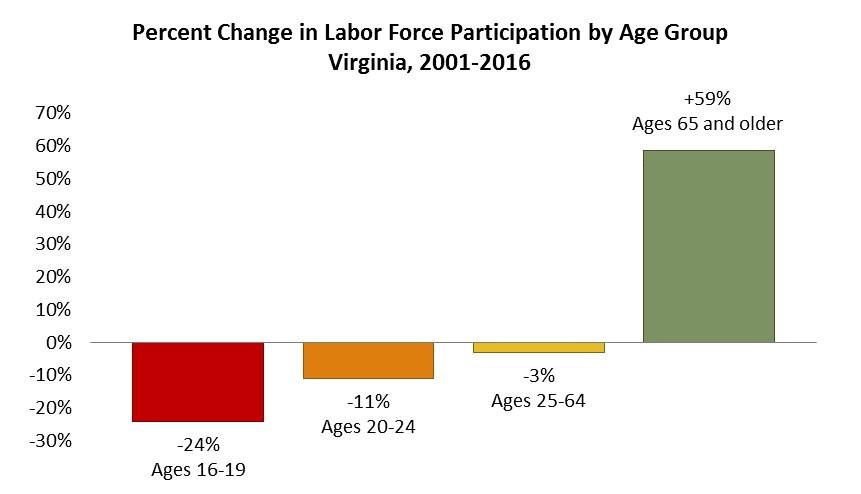Youth labor force participation and workplace readiness in Virginia
Recently, the Cooper Center’s Demographics Research Group (on behalf of Virginia’s Office of Career, Technical, and Adult Education) collected feedback about the workplace readiness skills of entry-level workers from nearly 400 Virginia employers and workforce professionals. One of the comments most frequently made by the survey respondents was that young, entry-level workers need more hands-on/real-life work experience to prepare them for the demands of the workplace. Youth labor force participation has recently been declining, however, which means that a larger share of this age group is postponing their obtainment of the valuable work experience that employers desire.
As the graphs below demonstrate, while Virginia labor force participation from 2001 to 2016 increased by 59 percent among those age 65 or older and decreased by only 3 percent among 25-to-64-year-olds, it decreased by 11 percent among 20-to-24-year-olds and by 24 percent among those age 16 to 19. At the national level, the recent labor force participation rate among teens—including in the summer months—is the lowest it has been since Current Population Survey (CPS) data were first collected in 1948.


In addition to increased competition with older workers for jobs, another explanation for the recent decline in labor force participation among youth is that their rate of school enrollment has increased. Until 1990, both school enrollment and labor force participation increased among Virginia’s youth age 16 to 24. After 1990, however, as school enrollment continued to increase, labor force participation among this age group began to decline. By 2010, the percentage of 16-to-24-year-olds enrolled in school (60.2%) exceeded the percentage participating in the labor force (58.3%).

As the red dashed line in the graph above shows, the labor force participation rate among youth also enrolled in school was lower in all decades than the labor force participation rate for the age group as a whole. In 2010, for example, 58 percent of youth overall participated in the labor force compared to only 43 percent of those who were enrolled in school. But what the red dashed line also shows is that labor force participation among those enrolled in school increased each decade from 1960 to 2000, falling only between the years 2000 and 2010. Although the recession during that time period likely worsened youth labor force prospects, the beginning of the decline in their labor force participation preceded the onset of the recession.
So what else might be causing the recent decline in labor force participation among youth? According to one recent Bureau of Labor Statistics report, it has not only been the increasing rate of school enrollment that has precipitated a decline in youth labor force participation, but also an increasing prioritization of the value of education in enhancing a youth’s life prospects. A greater proportion of teens are now choosing not to work in order to dedicate more of their time to school studies and to non-work-related extracurricular activities, perhaps to gain a competitive advantage in admission to postsecondary educational programs.
While it’s promising that a higher percentage of youth are now enrolled in school and enriching their lives with education, employers still seek and value entry-level workers who have honed their workplace readiness skills through hands-on work experience. With an increasing proportion of youth opting to attend school and to postpone entry into the workforce, school-based workplace readiness preparation like Virginia’s Workplace Readiness Skills program—incorporated into the curriculum of every Career and Technical Education course in the state—will and should become an even more essential element of every young person’s education in the future. In the absence of hands-on experience in the workplace, young people must also take individual responsibility for finding ways to incorporate and develop workplace readiness skills in the non-work-related activities in which they participate.


